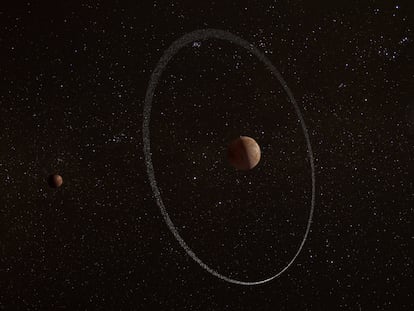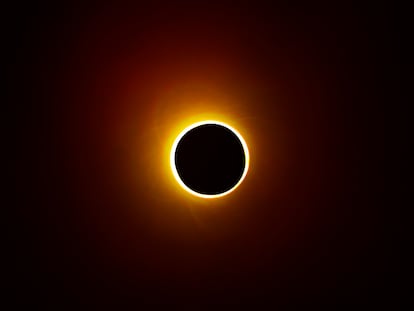A ‘termination event’ sets off the solar peak with geomagnetic storms and unique aurora borealis
The Sun’s activity has increased in recent months, and the peak of its life cycle, previously expected in mid-2025, seems to have moved to this year
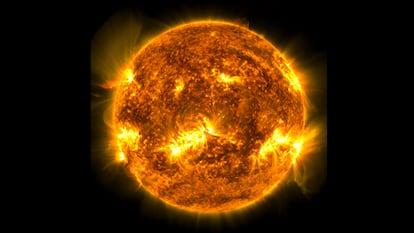
On the night of April 23, aurora borealis could be seen at very low latitudes close to the equator, far from their typical polar environment. The photogenic spectacle was visible in places including Texas and Extremadura, Spain, where the astrophotographer Lorenzo Cordero captured it in a photo chosen as the best of the day by NASA. “It is due to one of the largest magnetic storms that has happened in recent years, caused by a solar filament,” explains Consuelo Cid Tortuero, researcher at the University of Alcalá and scientist at the National Service of Space Meteorology (SeNMEs).
The phase known as the maximum of the solar peak seems to have moved forward a year, according to physicist Scott W. McIntosh, director of the National Center for Atmospheric Research (NCAR). Along with his documentation of sunspots, McIntosh bases his prediction on the information that his team has gathered over 20 years, comparing solar intensity data that goes back to 1750. Everything indicates that the peak of intensity will come in late 2023 or early 2024, which will imply a “termination event,” according to the scientists. The phenomenon occurs when an 11-year solar cycle ends abruptly, changing the star’s polarity, and begins again with greater intensity. When one solar cycle ends and the next begins, the Sun can experience huge magnetic field collisions that result in gigantic tsunamis of plasma that can charge the surface of the star for weeks.
Geophysicist Joan Miquel Torta confirms that we are in an unexpectedly active solar cycle, according to the estimates from the previous solar cycle. He compares it to living in a seismic zone: “There may be more activity, but not all of the events are critical,” Torta, the director of Ebro Observatory, says. In 2012, for example, there was a powerful solar ejection, but it did not reach Earth. For Cid, we are “on the way” to a solar peak, though he offers some nuance: “The worst part is the cycle’s descent, when there are a lot of filaments in the Sun.” These filaments are protrusions that can eject solar material into space, which pose a danger if they are oriented towards our planet. The higher number of sunspots means “more activity and a higher probability of something jumping out,” explains the scientist.
The general public should not be concerned about the Sun’s activity, although McIntosh says it worries him. “Someone has to be responsible if the electricity grid is damaged by a solar event and water can’t be purified. That’s important,” the physicist says.
Torta, an expert in geophysics security, categorizes the solar flares at their maximum as “events of low probability but very high impact,” due to the possibility of damage to the electric grid and satellites.
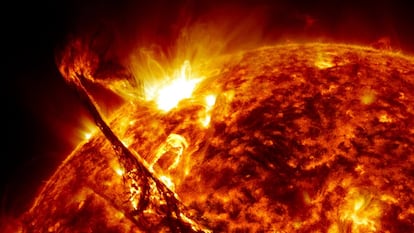
Our relationship to the galactic ecosystem has changed significantly in the last 100 years, due to the increase in satellites and electricity use. Our current way of life requires us to pay much more attention to solar flares, as “these phenomena start to affect technological systems, the infrastructure we have developed. That’s where our dependence comes from,” Torta says.
The vulnerability of the system
All the experts interviewed mention the Carrington event, named after Richard Carrington, the astronomer who documented it. In 1859, an extremely powerful solar flare fried the telegraphic networks of the United States and the United Kingdom, while night turned into day in the Caribbean, Hawaii and the Canary Islands. Another iconic event occurred in 1989 in Quebec, Canada, when the solar flare stopped the functioning of a hydroelectric plant and “millions of people were left without electricity for 12 hours,” recalls Miguel Herraíz Sarachaga, professor emeritus in the Physical Sciences department of the Complutense University of Madrid.
Today, we face new dangers with any overpowering of the system: the collapse of radio emissions, GPS navigation and communication satellites. “Geomagnetic storms influence a lot, and in situations of high electric conductivity, they affect the equipment,” Torta says.
“The destruction of an electric node could be a catastrophe. It would require months of work because of the difficulty of replacing the pieces,” Herraíz says. Space meteorology, which studies the physical conditions of the planetary system, is a growing field, due to the ever-expanding need to pay attention to the sky due to our dependence on telecommunication systems, which may be affected by intense solar phenomena.
The geomagnetism expert from Ebro Observatory considers that “we don’t need to be dramatic or paranoid, but we should analyze our vulnerabilities.” Miquel says that for an “extreme event” to occur, many extraordinary conditions must coincide: “Not only does the ejection have to reach Earth, but the magnetic field of the plasma that travels with the solar wind must have a polarity opposite to Earth’s magnetic field, causing a phenomenon called magnetic reconnection.”
The researcher says that each country needs “to know their electrical grid and analyze how dependent it is on its technology.” The geophysicist celebrates that society has also become “more resilient to climatic phenomena,” as has technology: our transformers and satellites are not the same as those of the seventies.
Southern auroras
Earth is completely subject to the Sun’s activity. When it reaches violent levels, in the form of eruptions or solar flares, the activity causes an increase in radiation and emissions of highly charged particles that directly affect our planet. When the solar wind — a great mass of plasma from the Sun — hits the Earth, a regular event, it provokes geomagnetic storms in the highest layers of the atmosphere.
In space meteorology, the most visible manifestation is known as the aurora borealis, visible from the North and South Poles. But if a strong storm hits, the auroras can be visible at lower latitudes, as occurred in the Southern United States and Europe several weeks ago.
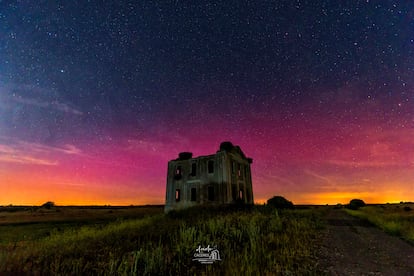
For Professor Herraíz, the increase in borealis sightings is an opening to talk about “the geophysics of Earth’s spacial environment.” A key aspect is the early detection of space meteorology phenomena, which can permit the adoption of preventative measures to decrease the potential damage resulting from extreme solar events. “The more science there is, the better information we’ll have, and prevention will be more precise.”
“The aurora is the most visible manifestation of the magnetic storms that cause mass to come from the Sun and impact the Earth,” says María Teresa del Río Gaztelurrutia, from the Planetary Science team at the University of Basque Country. The physicist clarifies that they are common, and only “massive events” can cause problems. Such incidents cause the sky to shine at twilight with unusual shades of purple, as the electrons and protons impact with Earth’s oxygen and nitrogen.
The star show observed in the twilight sky is the “friendly face,” says Professor Herraíz. Aristotle, Seneca and Pliny the Elder all spoke of inexplicable celestial lights, “which shows that auroras had been observed in our latitudes before, and that these atmospheric phenomena are as old as the world,” Herraíz explains. “It’s just that now we can detect them better.”
“What we see is the result of the impact of a coronal mass ejection that has traveled from the Sun to Earth’s magnetosphere, and the interaction of the highly charged particles dragged by the solar wind, which has penetrated the atmosphere of our planet,” the scientist adds. The light emitted by the particles as they lose energy produces a symphony of colors that we call auroras, but it also shows physical phenomena that occur at an atomic scale. That interaction “makes clear the existence of our atmosphere and the magnetic field of the Earth, and, in a certain sense, it makes it visible,” says the professor. Normally, “it has no danger in itself.”
Sign up for our weekly newsletter to get more English-language news coverage from EL PAÍS USA Edition
Tu suscripción se está usando en otro dispositivo
¿Quieres añadir otro usuario a tu suscripción?
Si continúas leyendo en este dispositivo, no se podrá leer en el otro.
FlechaTu suscripción se está usando en otro dispositivo y solo puedes acceder a EL PAÍS desde un dispositivo a la vez.
Si quieres compartir tu cuenta, cambia tu suscripción a la modalidad Premium, así podrás añadir otro usuario. Cada uno accederá con su propia cuenta de email, lo que os permitirá personalizar vuestra experiencia en EL PAÍS.
¿Tienes una suscripción de empresa? Accede aquí para contratar más cuentas.
En el caso de no saber quién está usando tu cuenta, te recomendamos cambiar tu contraseña aquí.
Si decides continuar compartiendo tu cuenta, este mensaje se mostrará en tu dispositivo y en el de la otra persona que está usando tu cuenta de forma indefinida, afectando a tu experiencia de lectura. Puedes consultar aquí los términos y condiciones de la suscripción digital.
